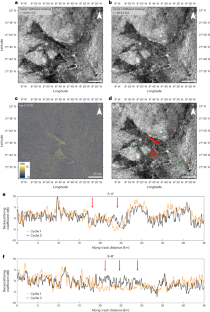2024-05-27 NASA
<関連情報>
- https://www.nasa.gov/centers-and-facilities/jpl/ongoing-venus-volcanic-activity-discovered-with-nasas-magellan-data/
- https://www.nature.com/articles/s41550-024-02272-1
- https://www.science.org/doi/10.1126/science.abm7735
マゼランレーダーが明らかにした金星の継続的な火山活動の証拠 Evidence of ongoing volcanic activity on Venus revealed by Magellan radar
Davide Sulcanese,Giuseppe Mitri & Marco Mastrogiuseppe
Nature Astronomy Published27: May 2024
DOI:https://doi.org/10.1038/s41550-024-02272-1

Abstract
The surface of Venus has undergone substantial alterations due to volcanic activity throughout its geological history, and some volcanic features suggest that this activity persisted until as recently as 2.5 million years ago. Recent evidence of changes in the surface morphology of a volcanic vent has been interpreted as a potential indication of ongoing volcanic activity. To investigate more widespread alterations that have occurred over time in the planet’s surface morphology, we compared radar images of the same regions observed from 1990 to 1992 with the Magellan spacecraft. We found variations in the radar backscatter from different volcanic-related flow features on the western flank of Sif Mons and in western Niobe Planitia. We suggest that these changes are most reasonably explained as evidence of new lava flows related to volcanic activities that took place during the Magellan spacecraft’s mapping mission with its synthetic-aperture radar. This study provides further evidence in support of a currently geologically active Venus.
マゼラン探査中に観測された金星火山の表面変化 Surface changes observed on a Venusian volcano during the Magellan mission
ROBERT R. HERRICK AND SCOTT HENSLEY
Science 15 Mar 2023
DOI:https://doi.org/10.1126/science.abm7735

Signs of volcanic activity on Venus
Numerous volcanoes have been identified on the surface of Venus, but none has been observed to erupt, so it has been unclear whether volcanic activity has ceased. Herrick and Hensley examined locations on Venus that were observed two or three times by the radar instrument on the Magellan spacecraft when it was searching for changes between the images caused by ongoing volcanic activity. The authors identified a volcanic vent that enlarged and changed shape in the 8-month gap between two radar images and a possible lava flow running downhill from the vent. The results are interpreted as active volcanism on Venus. —KTS
Abstract
Venus has a geologically young surface, but it is unknown whether it has ongoing active volcanism. From 1990 to 1992, the Magellan spacecraft imaged the planet’s surface, using synthetic aperture radar. We examined volcanic areas on Venus that were imaged two or three times by Magellan and identified an ~2.2-square-kilometer volcanic vent that changed shape in the 8-month interval between two radar images. Additional volcanic flows downhill from the vent are visible in the second-epoch images, although we cannot rule out that they were present but invisible in the first epoch because of differences in imaging geometry. We interpret these results as evidence of ongoing volcanic activity on Venus.


